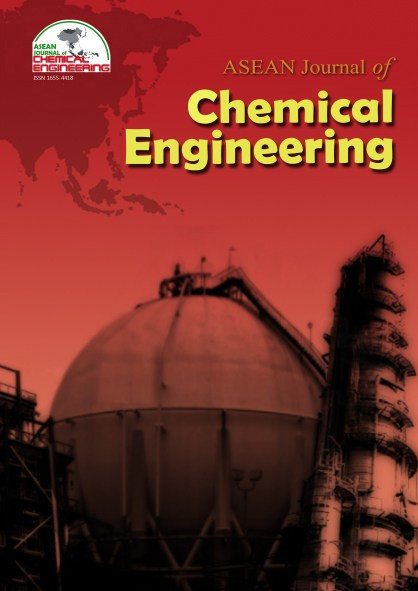Effect of Sintering Temperature on the Fabrication of Ceramic Hollow Fibre Membrane
Abstract
Recently, ceramic membrane gradually acquired attention from researchers due to the advantages of ceramic’s behavior, which allows the ceramic to overcome the limitations of using polymeric membrane. This work focused on the fabrication of ceramic hollow fibre membrane from a ceramic suspension solution containing yttria-stabilized zirconia (YSZ), polyethersulfone (PESf), N-methylpyrrolidone (NMP) and dispersants using combined phase inversion sintering technique. In this study, ceramic hollow membrane precursors were sintered at different sintering temperature ranging between 1250°C and 1400°C. The influences of sintering temperature on the microstructure, porosity and pore size distribution, mechanical strength and pure water flux of ceramic hollow fibre membrane were investigated in detail. The results show an asymmetric structure of YSZ hollow fibre membrane containing finger-like structure and sponge-like structure. The sponge-like structure can serve as a separation layer, while finger-like-structure performs as a supported layer. It is observed that sintering process caused a significant densification of sponge-like structure (microstructure). Sintering at temperature 1400°C shows the formation of non- interconnected voids. Sintering at 1300°C is sufficient enough having a mechanical strength of 227.55MPa with an apparent porosity of 45.09% and PWF of 118.39L.m¯².hr¯¹.
References
2. Khemakhem, S., Larbot, a. & Ben Amar, R., 2009. New ceramic microfiltration membranes from Tunisian natural materials: Application for the cuttlefish effluents treatment. Ceramics International, 35(1), pp.55–61.
3. Kingsbury, B.F.K. & Li, K., 2009. A morphological study of ceramic hollow fibre membranes. Journal of Membrane Science, 328(1-2), pp.134–140.
4. Li, K., 2007. Ceramic Membranes for Separation and Reaction,
5. Li, K., Tan, X. & Liu, Y., 2006. Single-step fabrication of ceramic hollow fibers for oxygen permeation. Journal of Membrane Science, 272(1-2), pp.1–5.
6. Liu, S. et al., 2001. hollow fibre membranes. , 193, pp.249–260.
7. Liu, S., Li, K. & Hughes, R., 2003. Preparation of porous aluminium oxide (Al2O3) hollow fibre membranes by a combined phase-inversion and sintering method. Ceramics International, 29(8), pp.875–881.
8. Liu, Y. & Li, K., 2005. Preparation of SrCe0.95Yb0.05O3–α hollow fibre membranes: Study on sintering processes. Journal of Membrane Science, 259(1-2), pp.47–54.
9. Othman, M.H.D. et al., 2010. Morphological studies of macrostructure of Ni–CGO anode hollow fibres for intermediate temperature solid oxide fuel cells. Journal of Membrane Science, 360(1-2), pp.410–417.
10. Rahman, M. a., García-García, F.R. & Li, K., 2011. On-board H2 generation by a catalytic hollow fibre microreactor for portable device applications. Catalysis Communications, 16(1), pp.128–132.
11. Wei, C.C. & Li, K., 2008. Yttria- Stabilized Zirconia ( YSZ ) -Based Hollow Fiber Solid Oxide Fuel Cells. Ind.Eng. Chem.Res, pp.1506–1512.
12. Yin, W. et al., 2009. Highly asymmetric yttria stabilized zirconia hollow fibre membranes. Journal of Alloys and Compounds, 476(1-2), pp.566–570.
13. Zhang, X. et al., 2010. Highly permeable porous YSZ hollow fiber membrane prepared using ethanol as external coagulant. Journal of Alloys and Compounds, 494(1-2), pp.366–371.
Copyright holder for articles is ASEAN Journal of Chemical Engineering. Articles published in ASEAN J. Chem. Eng. are distributed under a Creative Commons Attribution-NonCommercial 4.0 International (CC BY-NC 4.0) license.
Authors agree to transfer all copyright rights in and to the above work to the ASEAN Journal of Chemical Engineering Editorial Board so that the Editorial Board shall have the right to publish the work for non-profit use in any media or form. In return, authors retain: (1) all proprietary rights other than copyright; (2) re-use of all or part of the above paper in their other work; (3) right to reproduce or authorize others to reproduce the above paper for authors’ personal use or for company use if the source and the journal copyright notice is indicated, and if the reproduction is not made for the purpose of sale.



